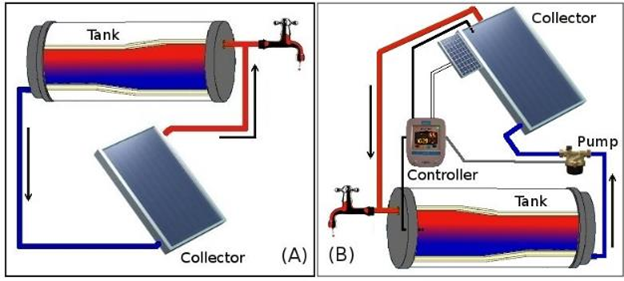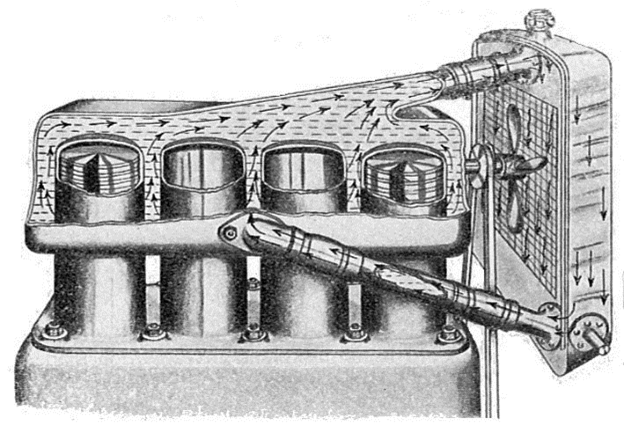With its ever-increasing capabilities, computing's role in modern technology has come with an exponential demand for cooling and thermal management. The most recent "frosty new tech" that has made its way into the consumer computing world is the thermosiphon. Thermosiphons may eventually replace standard heat sinks, heat pipes, water cooling, and other thermal management devices, so let's explore what they are and how to use them.
What is a Thermosiphon?
A thermosiphon is a passively driven thermal management device that utilizes the motive forces of natural convection and conduction. The device uses these forces to create a cyclic fluid flow from areas of high heat to low heat and back. You'll see the term thermosiphon used in various industries such as solar energy collection, automotive systems, and electronics.
Like standard siphons, thermosiphons don't require mechanical or electrical pumps to move fluid through an open or closed-loop system. Electronics cooling only uses closed-loop systems, since a thermosiphon's is typically water, refrigerant, or gas under sub-atmospheric pressure.

How Does a Thermosiphon Work?
Just as normal siphons rely on differential pressures between atmospheric pressure and a hydrostatic pressure vacuum, thermosiphons rely on the varying pressures created by density differences across different temperatures. These pressures are large enough to create substantial flow throughout a closed or open loop system.
In the image above, a thermosiphon heats a water tank using solar energy with the following process:
1. The collector absorbs solar energy and transfers that thermal energy from the sun into the water.
2. The warming of the water decreases its density, causing it to rise through the system.
3. The cooler substrate falls down the opposite side of the loop and into the collector.
If you reverse the relative position between the collector and tank, you'll need a pump to counter the natural hydrostatic force the thermosiphon produces. See below for an excellent illustration of a thermosiphon via a 1937 illustration of a radiator cooling the combustion chambers of a four-cylinder engine block. In this case, however, the cooling fluid likely changed phase, i.e., evaporated, when exposed to the combustion chamber and condensed through the radiator.

Thermosiphon Applications in Modern Consumer Electronics
Manufacturers design thermosiphons for electronics using the same premise as solar and automotive thermosiphons. However, given their use in high-power industrial applications, these designs are often proprietary. One soon-to-be-released thermosiphon-based cooling system for consumer computing is IceGiant's ProSiphon Elite CPU Cooler. This device is one of the first consumer-ready industrial-grade thermal management devices to use thermosiphon technology, as opposed to the heat pipe/ heat sink combinations we've seen more commonly. IceGiant's cooling method even outperforms liquid cooling devices. Because it doesn't require a pump, it may prove to be more reliable over time as well. Unlike liquid cooling, thermosiphons allow phase changing, which makes them more efficient at absorbing energy than liquid cooling.
Thermosiphon Advantages vs. Heat Pipes
When compared to thermosiphon cooling, heat pipes have one specific disadvantage: they rely on a wicking material to carry condensate back to the evaporator where it can properly change phase and absorb energy. In other words, the substrate (like water) within a heat pipe must be able to evaporate at the heating side, condense on the condensing side, and move through its wick via capillary action to work as a full thermal system. Given the ever-increasing energy demands of GPUs and CPUs, standard heat pipe and heat sink configurations are susceptible to becoming ineffective if too much energy is applied―a condition called "heat pipe dry out." This condition occurs when the heat pipe system absorbs too much heat, and the condensing wick can't carry the substrate to the primary heat source. Ultimately, the entire heat pipe stops moving heat away from a heat source. This heat pipe energy transfer threshold is called the "boiling limit." The geometry of the heat pipe determines this threshold, as well as the physical characteristics of the pipe and substrate.
Thermosiphons, on the other hand, rely exclusively on gravity and subsequent hydrostatic pressure to return the condensed or cooled fluid to the heat source. Their ability to move condensed fluid back to the heat source without relying on a wicking material may result in thermosiphon technology being deployed in the next wave of high-power processor cooling.
Electronics cooling will continue to expand along with computing requirements across all industries. The data center cooling market is even expected to reach a value of $8 billion by 2023. Given its demand in the foreseeable future, there's no doubt that we'll see thermosiphon technology at work in one form or another to help keep our tech cool, allowing powerful computers to run quickly and efficiently.

